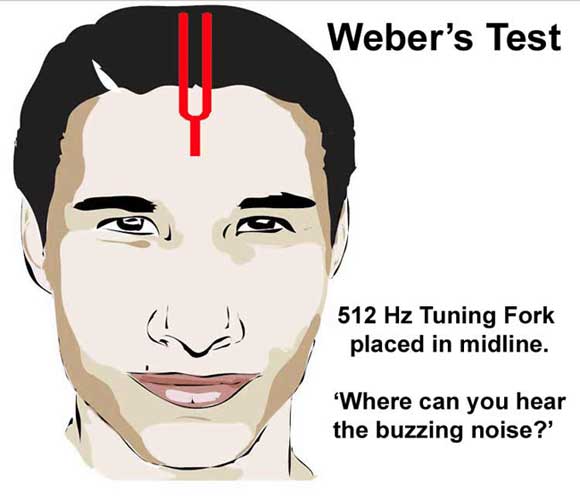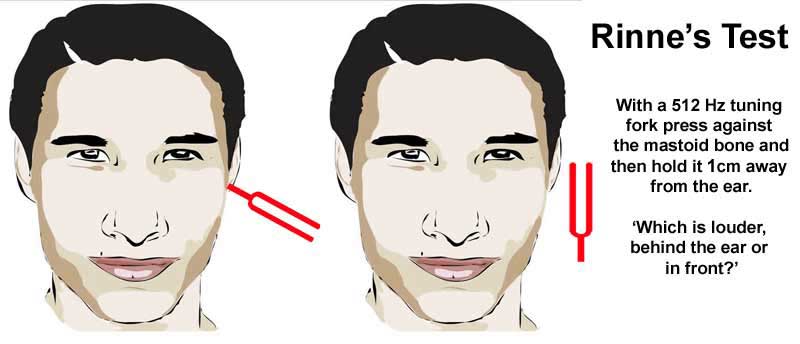The following document was written by Mr Vik Veer MBBS(lond) MRCS(eng) DoHNS(eng) in Dec 2007. You may use the information here for personal use but if you intend to publish or present it, you must clearly credit the author and www.clinicaljunior.com
This site is not intended to be used by people who are not medically trained. Anyone using this site does so at their own risk and he/she assumes any and all liability. ALWAYS ASK YOUR SENIOR IF YOU ARE UNSURE ABOUT A PROCEDURE. NEVER CONDUCT A PROCEDURE YOU ARE UNSURE ABOUT.
Tuning Fork Tests
Due to Popular demand - i have written this short guide purely on tuning fork tests. I hope to make this subject as easy to understand as possible for the busy clinician.
There are two main tuning fork tests Rinne’s and Weber’s tests. They are used mainly to detect functional defects in hearing.
There are broadly two types of hearing loss:
• Sensorineural (i.e. when the inner ear is damaged, either the cochlear and / or cochlear nerve)
• Conductive hearing loss (when there is disruption of the sound reaching the inner ear through the normal method of using the tympanic membrane and transmitting vibrations through the middle ear bones.)
These tests both exploit the fact that in normal people the ear is more sensitive to sound via the air (i.e via the middle ear mechanism) compared to bone conduction (i.e ‘hearing’ the sound transmitted as vibrations through the bone of the skull). The also rely on the fact that when there is a purely conductive hearing loss in one ear, that ear becomes more sensitive to bone conduction hearing compared to the normal side. This may be due to the fact that now the affected ear is subject to less environmental noise compared to the normal side and therefore becomes more sensitive to the vibrations through the skull.
Weber’s Test
The image below shows how to perform this test.
Strike the 512Hz tuning fork lightly on your elbow or knee (so that you can barely hear it at arms length) and place the base of the lightly vibrating tuning fork firmly on the forehead (or any bone prominence in the midline of the skull – equidistant from both ears). Contrary to the image the ‘prongs’ of the tuning fork should strictly be in line vertically (i.e. one on top of each other) when used in this test.
A normal result is when the patient can hear the tuning fork tone in both ears equally.
An abnormal result is when the patient can hear the tuning fork tone in one ear more than the other.
Unfortunately this test does not differentiate between conductive and sensorineural hearing loss – it can’t even really tell you which side is affected. Say for example that the patient found that he could hear the tone more on the right side compared to the left. This could mean that the left ear had a sensorineural hearing loss and therefore the tone went to the right because that is the only ear that can hear. Or it could mean that the right ear has a conductive hearing loss and therefore the right ear has become more sensitive to bone conduction and so hears it better than the left.
Therefore this test is merely a test of difference in function between the two ears. No more information can be gained really from this test.
Rinne’s Test
Again strike the tuning fork lightly and then place the base of the tuning fork firmly on the bone of the mastoid on one side. Be sure to place the fork directly on the bone rather than on the tissues surrounding it. Once the patient can hear this, place the prongs of the tuning fork 1 cm away from the external auditory canal and ask if the noise is louder when placed against the bone or when held up next to the ear. The image below shows this procedure.
A normal test is when the patient can hear the tuning fork easier when held 1 cm from the EAC rather than when placed on the bone. Strangely a normal Rinne’s test is called a ‘Positive Rinne’s test’, although I would recommend you just explain your findings rather than sticking to this confusing terminology.
If the patient can hear the sound better when the tuning fork is placed on the mastoid then it would appear that this patient has a conductive hearing loss on that side.
Make sure that the patient ‘hears’ the sound in the ear that is being tested – occasionally in patients with very bad hearing, accidentally hear the tuning fork tone not in the hear being tested but in the other better performing ear. You may have to ‘mask’ (deliver a very noisy environment), the good ear in this situation to cancel out the effect of this ear in picking up the vibrations from the other side of the skull.